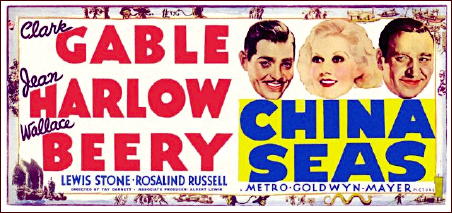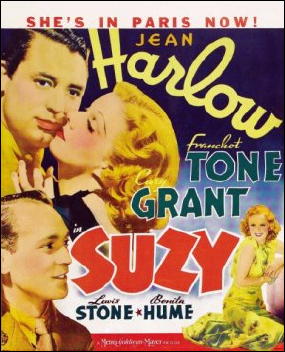May 2010
Monthly Archive
Sat 15 May 2010
Posted by Steve under
Reviews[3] Comments
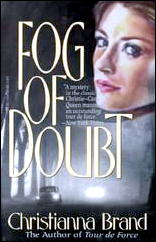
CHRISTIANNA BRAND – Fog of Doubt. Carroll & Graf, paperback reprint, 1984. Hardcover edition: Charles Scribner’s Son, US, 1953. First published in the UK as London Particular, hc, 1952. Earlier US paperback: Dell #881, 1953.
On the night of a terrific London fog, a murder is committed, and only a handful people could have done it – excluding the ubiquitous tramp, of course. Inspector Cockrill’s problem is that all of them have alibis and/or no motive.
This is supposedly a classic of detection, in which it all comes down to the last line, but in my opinion? I’m not so sure.
Either it was a spontaneous crime, a chance opportunity quickly taken, or a devious scheme completely planned in advance. It can’t be both, and as far as I can see, the ending just doesn’t work. The events described are simply in the wrong order.
Worse, a conversation a police officer overhears on pages 93-94 reveals quite a bit of information they, the police, could have used, but it’s Never Mentioned Again. (In a bit of Confusion on my part, I thought the police must have been in on the killing…!?)
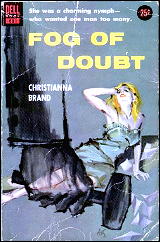
Cockrill has barely any presence in the story at all — I got the feeling the case would have ended exactly the same way, with or without him. The tradition of Christie-Carr-Queen is mentioned on the front cover, but if this is one of Brand’s best, it is easily seen why she’s mostly forgotten today.
PostScript: This is the kind of commentary you’re forced to resort to when you don’t want to give too much of the story away, but when the story is essentially the ending, what else can you do?
— Reprinted from Mystery*File #35, November 1993, somewhat revised.
[UPDATE] 05-15-10. What this kind of negative review on my part makes me want to do today is find my copy of the book and read it again, especially since the author is still well regarded today.
I seldom pan a book as severely as I did this one, so what I’d really like to know now if it’s really as bad as I thought it was then. Did I read it wrong? Was there something I missed? I don’t know, and I wish I did.
[UPDATE #2] 05-17-10. I’ve just posted Marcia Miller’s review of Green for Danger, one of Christianna Brand’s earlier mysteries (1945). I mention this because I quoted from her review in my Comment #2.
I’ve also belatedly discovered that Kevin Killian reviewed Fog of Doubt here on the blog about a year and a half ago. He goes much further into detail about the plot, finds some of the same problems with it, but overall he liked the book much more than I did. Follow the link, and you’ll see what I mean.
Sat 15 May 2010
Posted by Steve under
Reviews1 Comment
IT IS PURELY MY OPINION
Reviews by L. J. Roberts
MAGDALEN NABB – The Marshal and the Murderer. Charles Scribner’s Sons, hardcover, 1988. UK edition: Collins Crime Club, hc, 1987. Paperback reprint: Penguin, 1988. Trade paperback: Soho Press, 2003.
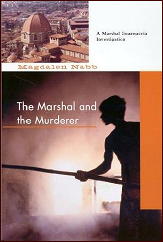
Genre: Police procedural. Series character: Marshal Guarnaccia, 5th in series. Setting: Florence, Italy.
First Sentence: “Well, I hope I haven’t taken up too much of your time…”
A very shy young Swiss woman asks the help of Marshal Salvatore Guarnaccia. Her roommate and friend, who has been studying pottery making in a small village outside Florence, has gone missing. With the help of the local marshal, Niccolini, Guarnaccia must uncover the secrets of the town and its history to solve the crime.
With each book, I come to like this series more. But I think my reticence was more my fault than the author’s. I started out comparing Nabb to Donna Leon, which isn’t fair as they are very different writers.
I also didn’t understand the structure of the Italian police forces, and I do fault Nabb for not clarifying that. Once I rectified those two things, I find Nabb has created a protagonist who has really grown on me.
The Marshal doesn’t consider himself to be smart and that he seems to be half-asleep on his feet. Although not in a Sherlock Holmes manner, he observes, considers and puts the information together in his own time.
He is big, clumsy, and allergic to the sun, loves his family but is accustomed to living on his own, and I think he’s a great character. However, it was fun, in this book, to see him working with Marshal Niccolini, who is hyperactive and, therefore, a delightful contrast.
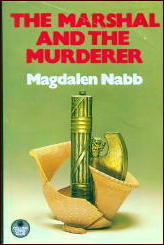
In considering the various aspects of Nabb’s writing, although I do wish Nabb provided a stronger sense of place, I cannot fault her voice and dialogue. She has a subtle humor which offsets some of the darkness to the story, and her dialogue has a very natural flow. Even when she doesn’t identify the speaker with each sentence, you know who is speaking. Not every author accomplishes this.
What I particularly liked was the plot. What starts as a “simple” disappearance and murder, leads to something much larger and darker, involving more than just the victim and the killer.
Nabb utilizes the theme of the sins of the father; “…I always hated that idea but when you think about it in concrete terms it isn’t a moral condemnation, just an observation of fact.” There is a well-done twist to the plot and an excellent, albeit somewhat sad, end.
Only the inclusion of a portent has dropping my rating from being “excellent” to “very good plus,” but I do highly recommend it.
Rating: Very Good Plus.
Editorial Comment: There are 14 books in Magdalen Nabb’s Marshal Guarnaccia series, the last appearing posthumously in 2008, a year after her untimely death. A death notice for the author appeared here earlier on this blog, along with a complete list of all her mystery fiction.
Sat 15 May 2010
A TV Review by MIKE TOONEY:
“An Out for Oscar.” An episode of The Alfred Hitchcock Hour (Season 1, Episode 26). First air date: 5 April 1963. Larry Storch, Linda Christian, Henry Silva, John Marley, Myron Healey, Alan Napier, David White, George Petrie, Rayford Barnes. Teleplay: David Goodis, based on the novel My Darlin’ Evangeline by Henry Kane (Dell, pbo, 1961). Director: Bernard Girard.
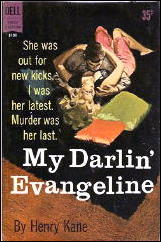
Only a blind man could fail to see that beautiful Eva Ashley (Linda Christian) is trouble from the get go. Since love is blind, it might explain why Oscar Blenny (Larry Storch) has fallen for her — hard.
While working at a Vegas casino, Eva has two-timed not just one but two possible meal tickets: Pete Rogan (Myron Healey) and Bill Grant (Henry Silva). Oddly enough, it isn’t Grant who kills Rogan, but Eva herself. The official verdict is self-defense, and Eva has no tears to shed for Pete.
Hoping to use Grant as a way out of a very uncomfortable situation, Eva tries to get him to take her to Mexico, where Grant has been exiled by their boss, Mike Chambers (John Marley). Chambers sees Eva as a liability, but more than that — “a chiseler” is how he puts it, and, brother, is he so right! But Grant is fed up with her, too, and abandons Eva on a lonely street corner.
Enter mild-mannered Oscar, a guest at the casino hotel. Eva’s got his number: He’s her next meal ticket. What makes him even more attractive is that he’s a bank teller in a Los Angeles bank — and if there’s one thing Eva can’t get enough of, it’s money. Oscar is totally taken in, and it’s wedding bells for them.
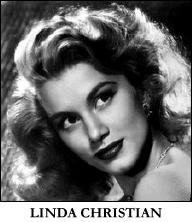
A couple of weeks have passed when Bill Grant, just back from his exile in Mexico, shows up at the Blennys’ apartment. In addition to a little nooky with Eva, Grant has a surefire “perfect crime” plan for stealing $250,000, needing only Oscar’s cooperation. Moreover, unknown to Eva, Grant has plans for that quarter million that don’t include her ….
… all of which will culminate in a perfect murder — done in broad daylight — with dozens of witnesses — AND the approval of the police.
Mystery*File readers who may be aficionados of “the perfect murder” should enjoy this one. By the end of the third act, the viewer is hooked: Just how is this tangled situation going to unravel? The ending is awash in irony. Good show.
Since 1950, Henry Silva has been ably playing villains in films and TV, e.g., The Untouchables, The Manchurian Candidate (1962), Johnny Cool (1963), Buck Rogers in the 25th Century (1979), Sharky’s Machine (1980), Dick Tracy (1990), and many others.
Larry Storch also appeared in “The Jack Is High,” reviewed here, a segment of the Kraft Suspense Theatre.
Hulu: http://www.imdb.com/video/hulu/vi1524105241/
Editorial Comment: As Rittster points out in Comment #1, a TV play written by David Goodis is a rarity. It was posted quite a while ago on this blog, but back in September 2007, Tise Vahimagi sent me an article in which he did a complete rundown of all of Goodis’s television credits, as well as W. R. Burnett’s. Check it out here.
Fri 14 May 2010
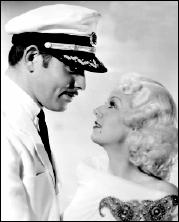
CHINA SEAS. MGM, 1935. Clark Gable, Jean Harlow, Wallace Beery, Lewis Stone, Rosalind Russell, Dudley Digges, C. Aubrey Smith, Robert Benchley, Hattie McDaniel. Director: Tay Garnett.
The opening scenes of this film both surprised and pleased me, filled as it is with passengers boarding Captain Alan Gaskell’s South Seas freighter, heading this time out from Hong Kong to Singapore, and those seeing them off, plus a huge contingent of assorted crewmen and hordes and hordes of bustling dock workers.
The modern touch in which each of the major players is introduced briefly but succinctly is quite a compliment to the director, Tay Garnett, whose career in movies and TV lasted over 50 years.
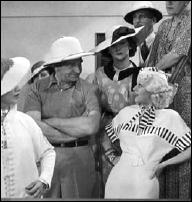
Gaskell is played by Clark Gable, and there is no doubt that he is master of his ship, cheery and easy going when he can and tough as nails when he has to be. But when he comes to women, well he’s no master, and doubly so when there are two of them on board, and both with plans of marriage on their minds.
Jean Harlow is the first of the two we meet, a brassy blonde dish named Dolly Portland (or China Doll), and she and Gaskell seem to have been a pair for quite a while, code or no code.
The aristocratic Rosalind Russell’s history with ship’s captain goes back many years before and England, where she married someone else — a wedding soon followed by Gaskell’s departure for the Far East. But that someone else has since died, and the new widow has headed straight for the China Seas with but two objectives in mind: to reclaim her former love and bring him back home.
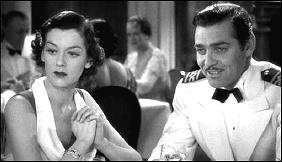
Do sparks fly? Boy, do they. Add in a slippery character named Jamesy MacArdle (Wallace Beery) who’s also around to comfort Dolly when she gets the blues, which is precisely the same time that Lady Sybil seems to be gaining the upper hand, which is very quickly.
Rosalind Russell, by the way, could easily be mistaken for Myrna Loy in this movie, and her far too cool beauty is never going to win the day, or so the viewer knows for sure, deep down inside, and from the very first time she appears on the screen.
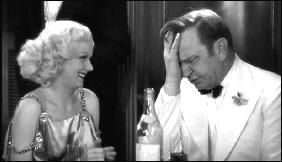
Add in some ferocious pirates with a eye on a small fortune in gold hidden somewhere on board, preceded by a typhoon which causes havoc to everyone and everything on board — and all of a sudden the viewer mentioned above has to swallow his or her first inclinations that this movie is little more a mild romantic romp in the park.
Even so, Robert Benchley as a drunken American author continually supplying wryly appropriate but still nonsensical non sequiturs at every odd moment, certainly does his funny man best, no matter what. (I am a long time Robert Benchley fan.)
It’s strictly star power that carries the day, as Jean Harlow shows once again that she could hold her own with any actor, even one with the screen presence as large as Clark Gable’s, in a role that’s absolutely perfect for her — and was probably designed that way from the start.
Fri 14 May 2010
Posted by Steve under
Reviews[7] Comments
Reviewed by DAVID L. VINEYARD:
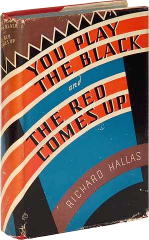
RICHARD HALLAS – You Play the Black and the Red Comes Up. Robert H. McBride, hardcover, 1938. Paperback reprint: Dell #510, 1951. Gregg Press, hardcover, Black Lizard Paperback, pb, 1986.
And it was California. We were on a sort of mountainside, and down below us was a valley where you could see the palm trees in a long row, and orange ranches and houses — all looking pretty as a fiddler’s floozie and smelling twice as good.
There is a type of novel that can only be called a peculiar classic, and by any standard this noirish Hollywood novel fits that category. Even more so when you know the pseudonymous Richard Hallas was better known by his real name, expatriate Englishman and member of the Hollywood Raj, Eric Knight.
Knight also wrote the classic novella “Lassie Come Home,” which spawned a long line of movies, television series, comics, and countless other media, and the inspirational wartime bestseller This Above All, which became a classic film with Henry Fonda, Joan Fontaine, and Thomas Mitchell.
But you wouldn’t know that from You Play the Black and the Red Comes Up (the title a reference to the roulette wheel — in this case an electronic one in a gambling joint — and the fickle nature of fate), a nightmarish tale that echoes both the American hard-boiled voice, Cornell Woolrich’s dark tales of obsession and implacable fate, and the Hollywood novel as it was developing when this was written in 1938.
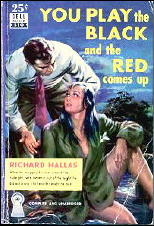
I went down to the tracks and waited there in the dark and when the 3:20 westbound freight came through I hopped it. I got up on top of a boxcar and lay there, looking back. You could see the glow of the smelters, maybe fifteen miles.
The narrator is Dick Dempsey, just dumped by his wife Lois with whom he ran a diner. He’s landed on a west bound freight and his next stop is Los Angeles — which in this book may as well be the Twilight Zone.
I kept thinking that the goofier the plan the more quickly people fall for it in California.
And Dick can be forgiven if he feels that way because the Los Angeles he lands in is eccentric to say the least, from a sexually dubious film director named Quentin Genter; to a pair of psychopathic floozies; Sheila a nice girl, who still isn’t entirely sane (he meets her at 2 am on an empty pier where she has just taken a nude swim and is in no hurry to get dressed); and as fine a collection of crooked cops, grifters, tarts, and Hollywood staples as you can imagine in any single novel. Plus three murders, one robbery, a suicide, multiple love affairs (mostly illicit), a murder trial, and shots at everything from Upton Sinclair’s gubernatorial campaign to Aimee Semple McPherson.
It was Patsy in her white robes and gold sandals … she was standing stock still with her arms stretched out and her hands turned up, and with her head looking up in the air, like she was Christ on the cross.
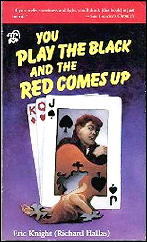
As you might expect in this kind of tale, Dick ends up on death row waiting for death after breaking a few laws and getting framed for the one he is innocent of, but the ending still manages to be unexpected as Dick gets a reprieve from that fate to meet another and has a sort of epiphany as he escapes the California asylum.
I think it was true what Genter once said: that the minute you crossed into California you went crazy. And I think the minute you cross the mountains coming back, you change again… I remember him saying that some lands were father to a man; and some were mother to him, and loved him; and some were a wife, and had to be loved; but California was just a whore who dropped her pants to the first man who came along with a watering-pot.
Critical reception of You Play the Black and the Red Come Up was mixed, with some critics feeling Knight was slumming, aping the then new hard-boiled voice, but this a remarkably sustained effort, and the disparate elements compare well with Edward Anderson’s Thieves Like Us, Horace McCoy’s They Shoot Horses Don’t They, or James M. Cain’s novels, not to mention Nathaniel West’s The Day of the Locust, Fitzgerald’s The Last Tycoon, and Raymond Chandler’s The Little Sister.
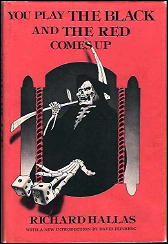
Dick Dempsey’s voice is done in perfect pitch and never fails to be real and convincing, his journey, complete to its hallucinogenic end, the genuine thing, a true hard-boiled Hollywood novel of its period, and a genuine peculiar classic as well.
This is a hard one to find. The Gregg Press reprint with a fine introduction by David Feinberg is likely your best bet. Best of all, like a fly in amber, the book captures a slightly distorted but none the less true picture of Los Angeles in 1938 when movies were king and California still the golden land at the end of the dark and dusty Depression road.
… I thought about all the things they’d said abut Genter after he was dead, but it didn’t matter; because he knew more than they did. Anyhow, he was the only man in California with sense enough to know he was crazy.
Nathaniel West couldn’t — and didn’t — say it better.
Fri 14 May 2010
RAY HOGAN – Guns Against the Sun. Avon T-453, paperback original, 1960. Macfadden, pb reprint, 1968.
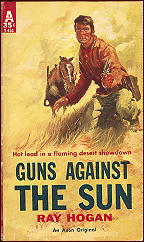
Although I own (and have cataloged) somewhere over 65 paperback westerns written by Ray Hogan, this is the first one that I can remember reading, which on the basis of Guns Against the Sun is my error – certainly no one else’s.
And I suspect that the total output of westerns written by Ray Hogan would easily top the one hundred mark – he was that prolific during his peak years of the 1960s and 70s. He had one series character that I recall, Shawn Starbuck, a young cowboy whose wanderings across the Old West led him into many adventures.
Only 157 pages long, Guns Against the Sun is barely more than a long novella, and it can easily be read in a couple of hours. Plotwise it goes something like this: when a gang of bank robbers hits Marshal John Banning’s town, they not only make off with a small fortune in gold, but they also shoot and kill Banning’s teen-aged nephew, his only remaining kin.
The posse of townfolks that Banning takes with him doesn’t last long. Forced to follow the trail into the desert alone, he comes across a wagon heading west driven by a woman whose ailing husband is of no help to her, either against the heat of the sun or the outlaws Banning are chasing.
That about sums it up, a minor piece of work in many ways, but Hogan’s eye for character as well as the desert country, brutal in direct daylight but unaccountably beautiful in the night time, makes this particular western rather easy to recommend. Brief but to the point. Hogan knows his West, all right.
Fri 14 May 2010
A 1001 MIDNIGHTS Review
by Art Scott:
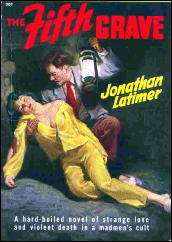
JONATHAN LATIMER – The Fifth Grave. Popular Library #301, paperback original; 1st US printing, 1950. Methuen, UK, hardcover, 1941, as Solomon’s Vineyard. Magazine appearance: Mystery Book Magazine, August 1946. Reprinted several times, including: Jonathan Press #J65, digest-sized paperback, 1950s; Pan, UK, pb, 1961. International Polygonics, pb, 1988; Neville, hardcover, 1982: limited edition, 300 copies, 26 additional bound in leather; first unexpurgated US edition. (Each of the latter two editions were entitled Solomon’s Vineyard. Note that the IPL paperback is also unabridged, and the Pan may be.)
This book has a curious history. Published first in England in 1941, it didn’t see book publication in the United States until 1950 as a paperback titled The Fifth Grave, and then only in drastically expurgated form.
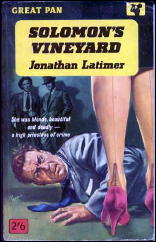
The first line of the original is “From the way her buttocks looked under the black silk dress, I knew she’d be good in bed.” The paperback version is “From the way she looked under the black silk dress, I knew she’d be a hot dame.”
It wasn’t until a small California publisher reprinted it in 1982 that the original text saw American publication, and then only in a limited edition of 326 copies. This is most unfortunate, as Solomon’s Vineyard is a genuine hard-boiled classic and deserves wide availability. It has everything!
A private eye; a shoot-out at a roadhouse; necrophilia; a shoot-out in a steam bath; mobsters; a crooked police chief, a bizarre religious cult; a knife fight in a whorehouse; kidnapping; a mystery woman with a taste for kinky sex; human sacrifice; crypt-robbing — you name it, detective Karl Craven has to deal with it.
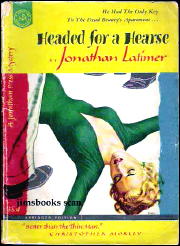
Craven, a crude but very tough investigator (very reminiscent of Hammett’s Continental Op in style and physique), arrives in the small Missouri town of Paulton to help his partner get a young woman out of the cult’s sanctuary, Solomon’s Vineyard, which dominates the life of the town.
He finds his partner’s been shot dead. Soon thereafter, he finds himself a target of the local mob, who control the countrywide vice operations in concert with the elders of the cult.
The cult’s founder, Solomon the Prophet, has been dead for five years, embalmed under glass for viewing on Sunday; but he takes a bride every year, and the brides mysteriously disappear just after the ceremony.
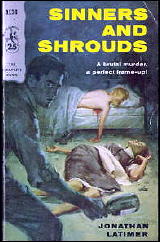
By “romancing” the cult’s priestess (the one with the black silk dress-and a fondness for S&M), he arranges a falling-out between the mob and the cult (a la the Op in Red Harvest), and ultimately finishes his job.
For this book, Latimer adopted an exceptionally terse first-person narrative style (the Bill Crane novels are told in more expansive third-person prose): The average sentence length is perhaps six or seven words. The comic elements are less overt, but he indulges his taste for Grand Guignol with evident relish.
Solomon’s Vineyard is clearly Latimer’s homage to the classic hard-boiled detective story, made obvious by Craven’s reading Black Mask during a couple of brief lulls in the action (shades of Bill Pronzini’s “Nameless”). As such it is a brilliant success, and deserves to be ranked with the best of Hammett, Whitfield, Cain, Davis, Chandler, et al.
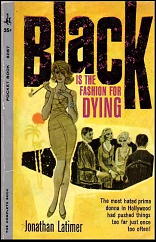
Other fine Latimer novels, all but the last two with Bill Crane: Murder in the Madhouse (1935), Headed for a Hearse (1935), The Dead Don’t Care (1938), Sinners and Shrouds (1955), and Black Is the Fashion for Dying (1959).
———
Reprinted with permission from 1001 Midnights, edited by Bill Pronzini & Marcia Muller and published by The Battered Silicon Dispatch Box, 2007. Copyright © 1986, 2007 by the Pronzini-Muller Family Trust.
Thu 13 May 2010
Posted by Steve under
Reviews[15] Comments
THE BACKWARD REVIEWER
William F. Deeck
JONATHAN LATIMER – The Fifth Grave. Popular Library #301, paperback original; 1st US printing, 1950. Methuen, UK, hardcover, 1941, as Solomon’s Vineyard. Magazine appearance: Mystery Book Magazine, August 1946. Reprinted several times, including: Jonathan Press #J65, digest-sized paperback, 1950s; International Polygonics, pb, 1988; Neville, hardcover, 1982: limited edition, 300 copies, 26 additional bound in leather; first unexpurgated US edition. (Each of the latter two editions were entitled Solomon’s Vineyard. Note that the IPL paperback is also unabridged.)

Although The Fifth Grave was published in 1946 in Mystery Book Magazine, the Popular Library edition is the first US printing in book form.
Some British spellings in the Popular Library edition lead to the surmise that Mystery Book Magazine used the British edition but edited it so that it would seem more current — there is a 1946 date in the novel that couldn’t have been in the 1941 edition — and then Popular Library copied the novel directly from the magazine.
Karl Craven, who does not live down to his name, arrives in Paulton, which apparently is somewhere in the Missouri wine country (Wine? Missouri?), to remove a young lady from the clutches of a religious cult, a cult whose raison d’etre, other than controlling the gambling, liquor, and prostitution in the area, is unclear.
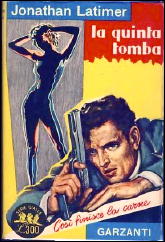
Craven’s partner, Oke Johnson, had arrived in town earlier and is shot with a silenced rifle the night Craven shows up. Craven has to complete his assignment before he can take time to find out who killed Johnson, not that he cares a great deal:
“But I had to get the guy who shot him. It would be swell to have people point me out as the private detective who wasn’t bright enough to find his partner’s murderer.”
So much for good old Oke.
Wiliness and cunning, and 240 pounds, are what Craven has going for him. Luckily, the bad guys, who are numerous even outside the cult, are less intelligent than he is. He attains his ends by playing the baddies off against each other. And he uses and abuses the Princess, a prominent person in the cult and, of course, gorgeous.
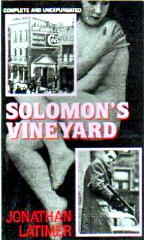
The Princess’s primary interests are in beating and being beaten by Craven before sex and accumulating enough money so that she can leave the cult and live in comfort. Her brains, therefore, are mostly not in her head.
A hearty eater and an even heartier drinker, Craven also has a fondness for pulp detective stories and the brassiere ads in movie magazines. Add to that his own code of honesty, leavened with immorality, and a complex character is produced.
Update a few items, make the sex and language more explicit, and the novel would fit right in in today’s literature. It would also be better than most.
– From The MYSTERY FANcier, Vol. 10, No. 2, Spring 1988.
Editorial Comments: Not included in this review are some introductory comments and speculations Bill made concerning the origins of this novel. For a lengthy appraisal of Jonathan Latimer’s fiction by John Fraser, including a complete bibliography, go here on the primary Mystery*File website.
Disclaimer by Karl Craven found at the front of the Methuen edition:
“Listen. This is a wild one. Maybe the wildest yet. It’s got everything but an abortion and a tornado. I ain’t saying it’s true. Neither of us, brother, is asking you to believe it. You can lug it across to the rental library right now and tell the dame you want your goddam nickel back. We don’t care. All HE done was write it down like I told it and I don’t guarantee nothing.”
Reviewed previously on this blog:
The Lady in the Morgue (by Curt Evans)
Thu 13 May 2010
REVIEWED BY WALTER ALBERT:
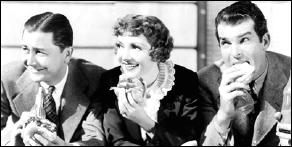
THE BRIDE COMES HOME. Paramount, 1935. Claudette Colbert, Fred MacMurray, Robert Young, William Collier, Sr., Donald Meek, Edgar Kennedy, Johnny Arthur, Jimmy Conlin. Screenplay by Claude Binyon, from a story by Elizabeth Sanxay Holding. Photography: Leo Tover; special photographic effects by Dewey Wrigley. Producer/director: Wesley Ruggles, producer/director. Shown at Cinecon 45, Hollywood CA, September 2009.
The best, and funniest, part of the film is the final scene in which the great Edgar Kennedy, playing a small-town Justice of the Peace, attempts to complete a ceremony uniting a reluctant Claudette Colbert and an eager Robert Young.
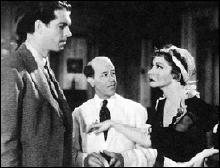
Meanwhile, suitor number two (Fred MacMurray) is racing in a car with the would-be bride’s father (William Collier, Sr) to stop the ceremony and claim the prize. This sequence lifts a charming romantic comedy into a more inspired comic realm.
And now you know why I referred to the “great” Edgar Kennedy. Everybody’s good, but he provides the comic leaven that not only puts the frosting on the cake but makes it rise to the occasion.
Thu 13 May 2010
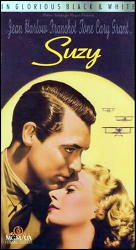
SUZY. MGM, 1936. Jean Harlow, Franchot Tone, Cary Grant, Lewis Stone, Benita Hume, Reginald Mason, Inez Courtney. Co-screenwriter: Dorothy Parker (one of four). Director: George Fitzmaurice.
So far as I can tell, and I may very well be wrong about this, here’s a movie with both Cary Grant and Jean Harlow in it, and it’s not available on DVD. It was released at one time on VHS, and I recently taped a copy from TCM, but there’s no other commercial release that I’m aware of.
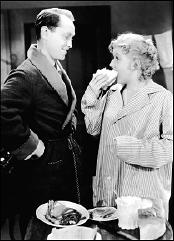
And why, you might ask, might that be? I wonder if it’s because Cary Grant’s image takes a beating in this movie. He probably played cads in movies other than in this one, but I hope I won’t be giving too much away to say that in the second half of this historical adventure drama he’s about as despicable as he can get.
As a down-and-out American showgirl in England, though, circa 1914, it’s really Jean Harlow’s film, all the way.
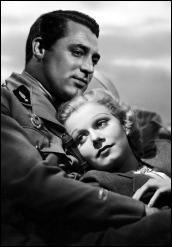
Franchot Tone is her lover and husband in the first half, the latter for less than an hour, a carefree inventor of airplane motors who whisks Suzy Trent (that’s Jean Harlow) off her feet before being killed by a gang of spies, or so Suzy believes.
And thinking she’ll be accused of the crime, Suzy heads off for France, which is where Cary Grant comes in. As a French war ace, he sweeps Suzy off her feet again, only to dump her in his father’s mansion while he heads off for the just declared war. And immediately returns to his carefree womanizing ways, the bounder.
I promised myself that I would refrain from telling you the complete story, and I haven’t, not yet, at least. I suppose I can safely add that the first half of the story eventually meets up with the second half, which is a lot more somber.
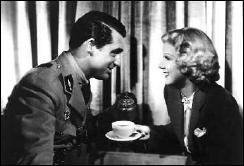
Wars have a way of doing that with stories, and the mood certainly changes once the Andre leaves Suzy and heads off for the front.
I’ve never been overly impressed with Jean Harlow’s acting ability, but as a screen personality, she was second to almost none, and that holds true for Suzy as well, especially in the first half of this film — but in the second half as well, where she wins over disapproving Andre’s father (Lewis Stone) in her own charming way, as only someone exactly like Jean Harlow could.
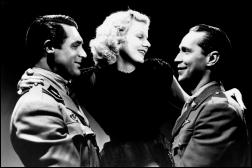
What part of the story Dorothy Parker wrote I don’t know, but I have to think she had something to do with the first half, which remains cheerful and light, in spite of the protagonists’ mutual lack of funds.
Living in poverty, if it can be refused to be taken seriously, sometimes does that to a tale, if it’s a Hollywood one, and this one definitely is.
PostScript: I found on YouTube a clip of the scene in which Suzy first meets Andre. Her singing voice, I’m told, is not Jean Harlow’s, but Cary Grant’s? Yes, that’s definitely his. A highlight of the movie. Watch it!
« Previous Page — Next Page »










